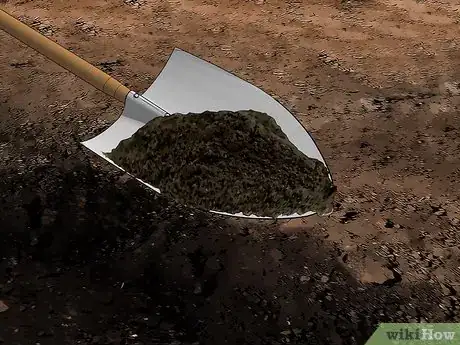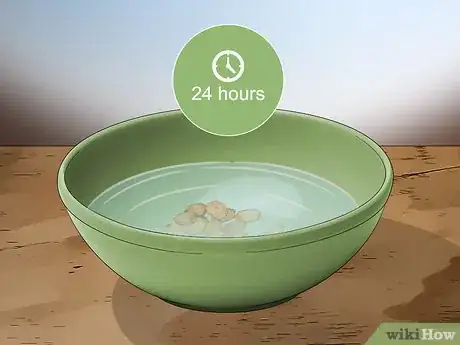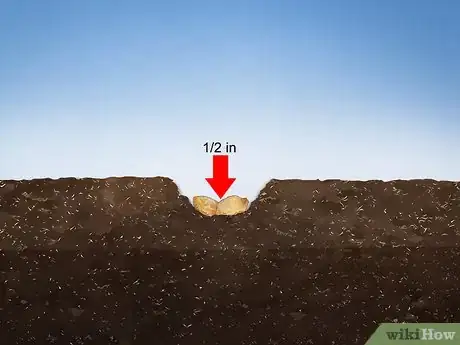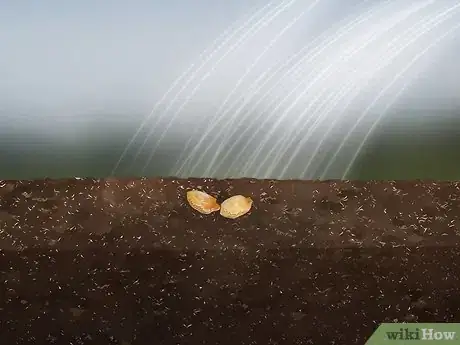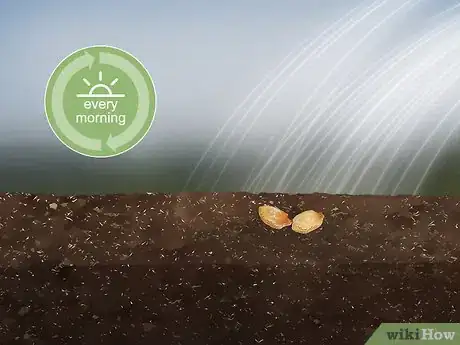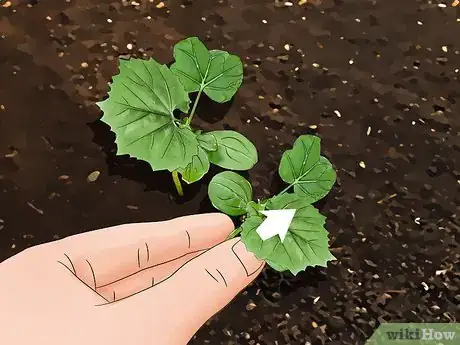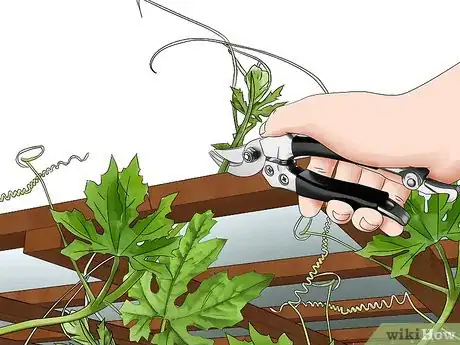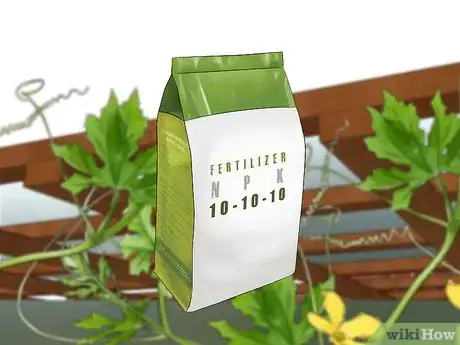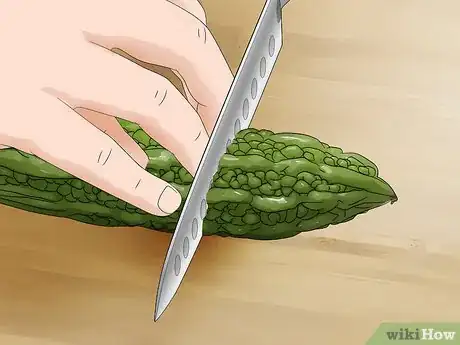This article was co-authored by Lauren Kurtz and by wikiHow staff writer, Hunter Rising. Lauren Kurtz is a Naturalist and Horticultural Specialist. Lauren has worked for Aurora, Colorado managing the Water-Wise Garden at Aurora Municipal Center for the Water Conservation Department. She earned a BA in Environmental and Sustainability Studies from Western Michigan University in 2014.
This article has been viewed 49,832 times.
Bitter melon, also known as karela or bitter gourd, is a fast-growing relative of the cucumber that is native to South Asia.[1] It is known for its knobby, oblong fruit and a flavor even more bitter than grapefruit. If you live in a hot and humid climate and provide proper care, you too can have success growing this nutritious fruit!
Steps
Setting Up a Growing Area
-
1Plant after the last frost when temperatures are 75–80 °F (24–27 °C). Even though bitter melon is more resistant to the cold than other plants in its family, frost will kill it. Though it may vary depending on your location, you are usually safe planting your seeds in late April or early May.[2]
- Bitter melon can grow at a minimum temperature of 65 °F (18 °C), but it will grow slower than it would in warmer temperatures.
- You can also grow bitter melon in a greenhouse to prevent frost damage.
-
2Find an area with 6 hours of direct sunlight. Although a few hours of shade is okay throughout the day, bitter melon prefers a location that has full sun. Seeds can be planted in shade as long as the vines can reach the sun once they grow.[3]Advertisement
-
3Add compost or manure to well-drained soil. Mix in organic materials to add nutrients to the soil before you plant your seeds. Bitter melon prefers soft, sandy soil, so mix in sand if you need to.[4]
- The soil pH should be between 5.5 and 6.7 to grow healthy melons.
-
4Build a trellis for the vines to climb. Make sure the trellis is at least 6 feet (1.8 m) tall so the vines have room to grow and wrap around it. Shape the trellis like the letter "A" over the growing area. Growing on a trellis will help prevent diseases, make harvesting easier, and produce larger fruit.[5]
- Bitter melon that is grown directly on the ground will not produce fruit as large as a trellised plant.
- If you do not trellis your melons, add a layer of straw or mulch to create a barrier between the plant and the soil, keep the moisture in the soil, and prevent fruit rot.[6]
Sowing the Seeds
-
1Soak the seeds for 24 hours before planting. Put the seeds in a bowl of water and let them soak for a day. This helps the seeds germinate quickly once they are planted. After they have soaked, pat them dry with a paper towel.[7]
- Purchase bitter melon seeds from your local nursery or online.
-
2Plant 2 to 3 seeds in the same hole 1⁄2 in (13 mm) deep in the soil. Plant the bitter melon directly outside. Poke a hole in the soil with your finger and drop the seeds inside. Cover the hole with topsoil. If you plan to plant more than 1 bitter melon plant, space the holes 40 to 60 inches (100 to 150 cm) apart directly into the soil in your garden.
- Seeds can also be planted in small pots filled with potting mix if temperatures outside are not ideal. Seedlings can be transplanted after 15-20 days once they’re planted in pots.
-
3Water the soil until the top 1⁄2 in (13 mm) is damp. Use a watering can to gently wet the soil. Put your finger into the soil down to the first knuckle. The soil should feel moist, but not completely waterlogged.
-
4Continue to water the soil every morning. Water at the same time every day so you do not forget. You should start to see the seedlings germinating after 2-3 days. Make sure the soil is moist, but not completely wet.
-
5Thin the seedlings once they have 4 to 6 true leaves. Save the healthiest-looking seedling. Use a pair of small pruning shears to clear away the weaker growths by cutting them at the base.
- If the seedlings are all the same size, either thin them out randomly or wait another day or 2 to see which ones start to grow larger.
Caring for Your Bitter Melon
-
1Spray your bitter melon with fungicides to prevent disease. Bitter melon is susceptible to the same diseases that affect cucumbers and squash. Use a fungicide made for squash from your local garden store to prevent infections in your bitter melon.
- Common diseases your bitter melon may encounter are watermelon mosaic potyvirus, downy mildew, or leaf spot. Look for splotchy discoloration on the leaves of your plant.
- Fungal infections typically occur after long wet periods. Watch your plant carefully if there has been a lot of rain in your area.
-
2Apply an insecticide to prevent insect infestation. Cucumber beetles are a common pest and carry bacteria that can permanently damage the vines of your plant. Apply a pesticide with rotenone at dusk so you do not harm pollinators during the day. Follow the directions on the packaging so you don’t harm your plants.[8]
- Fruit flies could lay eggs in the fruit. If you notice fruit flies near your plant, protect individual fruit by wrapping them in newspapers or paper bags.
- Only use harsh chemicals if the infestation causes significant damage to your plant.
- If you are planning to eat your bitter melon, stick to pesticides that are safe for human consumption, such as liquid soap sprays, vinegar, or Bacillus Thuringiensis (Bt).
-
3
-
4Prune the tip of the main stem once it grows past the top of the trellis. Use a pair of pruning shears to cut the growing stem back by 2 inches (5.1 cm). This helps promote faster growth of fruit and puts the plant’s energy into the lateral vines that have grown from the main stem.[11]
- If you are not growing on a trellis, prune the growing vine once the first female flowers appear on the plant. Female flowers will have knobby green stems attached to yellow petals.[12]
-
5Fertilize with a balanced NPK formula throughout the growing season. Only apply fertilizer after the plant has 4 to 6 true leaves. A store-bought fertilizer meant for fruit and vegetables works well for bitter melon. Follow the directions on the label so you do not oversaturate the soil.[13]
- Water the soil immediately after you apply fertilizer so it has a chance to soak into the roots of your plant.
Harvesting the Fruit
-
1Pick fruits 12 to 16 weeks after planting when they’re still green. Use a pair of scissors to cut the hanging fruit from the vine. The fruit should be around 4 to 6 inches (10 to 15 cm) long and firm to the touch when they are harvested. They’ll appear light green, but they may have yellow streaks on the flesh.[14]
- Plants that are completely yellow and soft to the touch are overripe.
- The fruit’s bitterness may vary, even when it’s grown on the same vine.
-
2Harvest every 2 days after the fruit starts to ripen. More fruit will form from the same vine after you remove the fruit that’s already grown. Check your vines every other day to see if you have fruit ready to be cut down.[15]
- Fruit should be harvested before it fully ripens.
-
3Cook or eat the fruit raw within 3 to 5 days after you harvest. Keep the fruit in a plastic or paper bag in the fridge. Cut the fruit open and remove the seeds. Pair the fruit with garlic or spicy peppers to mask the bitter flavors of the melon.[16]
- You can parboil the fruit to reduce the bitterness, but it may change the texture.
- Bitter melon has healthy doses of potassium, iron, fiber, and high amounts of vitamins C, B1, B2, and B3.
References
- ↑ https://www.webindia123.com/garden/vegie/bittergourd.htm
- ↑ http://www.omafra.gov.on.ca/CropOp/en/spec_veg/cucurbits/bitm.html
- ↑ https://bonnieplants.com/growing/growing-bitter-melon/
- ↑ http://www.celkau.in/crops/vegetables/Bittergourd/bittergourd.aspx
- ↑ https://bonnieplants.com/growing/growing-bitter-melon/
- ↑ https://bonnieplants.com/growing/growing-bitter-melon/
- ↑ https://www.webindia123.com/garden/vegie/bittergourd.htm
- ↑ https://bonnieplants.com/growing/growing-bitter-melon/
- ↑ https://plantinstructions.com/tropical-fruit/how-to-grow-bitter-melon/
- ↑ http://www.omafra.gov.on.ca/CropOp/en/spec_veg/cucurbits/bitm.html
- ↑ https://bonnieplants.com/growing/growing-bitter-melon/
- ↑ https://youtu.be/bXQ53pu__wk?t=38s
- ↑ https://bonnieplants.com/growing/growing-bitter-melon/
- ↑ https://bonnieplants.com/growing/growing-bitter-melon/
- ↑ http://www.omafra.gov.on.ca/CropOp/en/spec_veg/cucurbits/bitm.html
- ↑ https://bonnieplants.com/growing/growing-bitter-melon/


